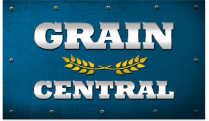
CSIRO’s Tony Swan, Warakirri Cropping’s John Stevenson and Greg Condon from Grassroots Agronomy speaking at last week’s Wagga Wagga Update. Photo: GRDC
INCORPORATING pulses into crop rotations can be profitable for commercial growers in southern New South Wales, but price volatility remains a key barrier, the Grain Research and Development Corporation’s Wagga Wagga Update heard last week.
After about ten years of plot-scale farming systems trials, CSIRO senior experimental scientist Tony Swan and a team from CSIRO, the NSW Department of Primary Industries and Regional Development, and Agrista modelled the results to a commercial-scale operation.
It compared the return on assets managed (ROAM) for traditional rotations featuring canola-wheat-wheat or canola-wheat-barley with a diverse mix, such as faba beans-canola-wheat or vetch hay-canola-wheat.
The researchers tested the farm analysis models by incorporating on-farm storage and investing in more resources like labour or equipment.
Based on the data from Temora, Greenethorpe and Urana, Mr Swan told the update there can be financial benefits to incorporating a pulse crop into a southern NSW farming system, but to achieve these gains, growers needed to maximise their “whole-farm efficiency”.
“Including a pulse crop can be profitable, sustainable and increase the resiliency of your farm at a whole farm level, but it is essential to match the scale of the farm to labour, plant and equipment units,” Mr Swan said.
He said logistics appeared to be the largest barrier to adoption, with about 2-4 percent of growers estimated to have a pulse in their system.
He said the price volatility of pulses made them a more difficult proposition when looking at ROAM compared to canola, wheat, or barley.
“The only thing we can do to reduce the variability and increase the profitability…is put in on-farm storage at the farmer’s cost and so that is critical at the moment to do.”
Mr Swan also urged growers to consider second-hand machinery when looking to increase farm resources, as over the past five years, new machinery costs had been going up “about 15pc every year”.
“It is having a massive impact on the bottom line.
“It’s a short-term fix until something can stabilise, but considering trying to buy quality second-hand machinery is a way to help a farmer’s whole-farm scale and their bottom line.”
He said this should be done alongside careful consideration of the pulse choice, with attention paid to topography and the grower’s skill level.
Warakirri backs pulse benefits
Corporate broadacre farmer Warakirri Cropping took part in the scaled-up farming systems research by providing data from its southern NSW operations.
The enterprise manages two aggregations totalling over 17,000ha in southern NSW and focused on growing wheat, barley, canola and pulse crops.
Warakirri manager south region John Stevenson said the business had trialed adding vetch, faba beans, and lentils to its rotations.
He said of the crops, faba beans appeared to be the most stable and had the best ROAM.
“We’re investing heavily to make faba beans a strong part of our rotation in the Riverina,” Mr Stevenson said.
“We’ve given lentils a try last year which has actually gone okay, but I think there’s so much data around the stability of faba beans as a good option that that…we’ve gone all in to try and make this work.”
He said the team wanted to increase biologicals’ activity in the system, as well as improving weed management and crop performance, and pulse crops appeared to be the ideal solution to this issue.
“Looking at getting a good solid rotation for weed management and for sustainability for our investor is critical across Victoria and NSW.
“We need to find some high-value pulses in the Riverina to really get things humming.”
Mr Stevenson said the operation makes decisions from a 10-year model using data over ten deciles.
He said the 10-year process gave “an output that should be pretty consistent with reality”.
He said modelling also demonstrated the benefits of on-farm storage over a longer term.
“In the modelling, what we found historically is that we’ve been achieving decile three pricing because we didn’t have storage and were forced sellers into a market that didn’t really want them.
“I think what we’ve assumed with good storage is that we can achieve decile five pricing, so we can get back to the average.
“We’re not assuming we’re going to get high prices for our beans, but we’re not going to get discounted by having to push them into the market that’s oversupplied at the wrong time of year.”
Mr Stevenson said the farming systems data gave the managers confidence in the decision to continue investing in pulse crops.
“When we’ve got an investor who’s looking for a return, we have to find every lever possible to pull to make that happen.
“I think the data that’s come out of farming systems trials (is) giving a bit of confidence to say…there are things we need to fix, and we can make this work.
“It’s certainly given us a solid foundation to build on.”
GRDC hosted the two-day event at Wagga Wagga last week, and the program covered topics related to soils, disease, nutrition, and insects.
Grain Central: Get our free news straight to your inbox – Click here

HAVE YOUR SAY